Q: I have a house-hunting question for you. What do you look for? What do you look past? Help! My main complaint of all the older homes that we’re looking at in our price range is that they all feel dated, but that seems to be what you guys look for. How do you know which dated houses are worth buying and which ones are lost causes? I keep worrying we’ll end up in a money pit! – Aviva (not the one from Housewives of NY).
A: First of all, I’m glad you clarified that you’re not NYC Aviva. Haha. And second of all, we actually get this question a lot. So when it comes to what we “look past” in a house (and what we pay attention to) my general answer is to never be deterred by the following things:
- baaaad paint on the walls or the trim
- nasty wallpaper (borders, or entire walls)
- dated or not-your-style furniture
- ugly curtains
- dark brick or paneling
- not-your-cup-of-tea light fixtures
- green/blue/pink toilets
For example, here are a few before photos of our first house to further demonstrate how off-putting those dated features can be… but we all know they can be remedied with a little elbow grease if you’re a willing DIYer:
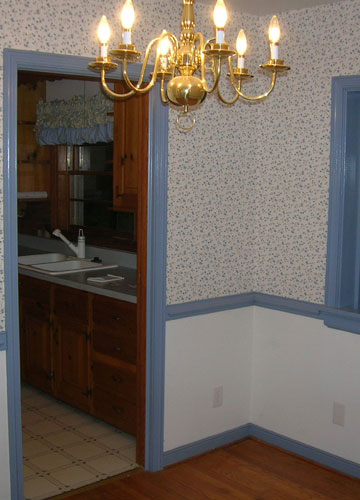
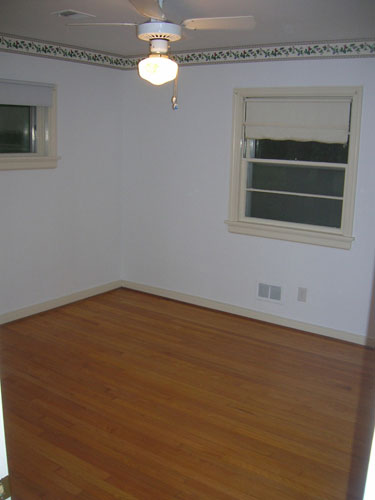
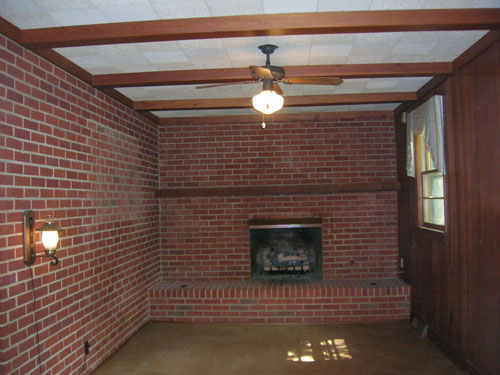
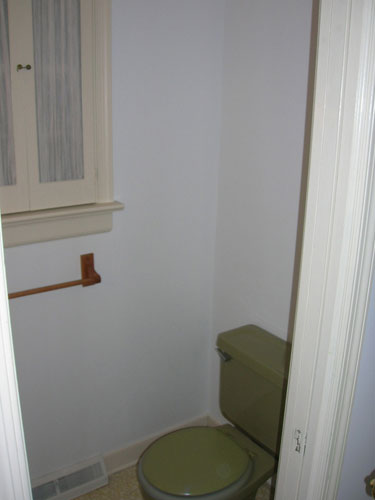
As for what we always try to pay attention to or look for, it’s mainly:
- the neighborhood (can’t move a house after you buy it)
- the overall layout (you can adjust some things, but repositioning every room gets pricey)
- the size of rooms and number of bathrooms, which is another hard-to-change factor (ex: if it has too-small bedrooms or one bathroom when you need two, you probably want to keep looking)
- things like ceiling height and window placement (which aren’t always easy to change)
- interesting architecture, like a fireplace, ceiling beams, etc
- the terrain of your lot (a steep drop off in the back isn’t exactly simple to fill in, etc)
Here are some photos of our first house that demonstrated some of those great “diamonds” that we saw in the rough. For example, the same room that showed dated brick and paneling also sports a nice cozy centered fireplace along with architectural beams overhead:

Which meant that once we painted all the dark wood and brick, it completely changed the feel of the room:

Another great selling feature for us was the lot itself. It was nearly an acre (something you can’t change once you buy a house) with a nice flat and wooded backyard:
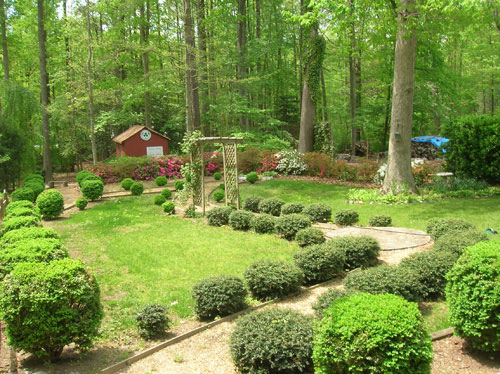
All that landscaping was a more than a little rough to stay on top of, but since we had a nice level lot that was private and wooded in the back, we knew it had tons of potential. And thanks to craigslist we got folks to dig stuff up for free (by posting you-dig-it-up-and-it’s-yours ads like this, which even worked for all that pea gravel) and we ended up with a nice easy-to-maintain yard that made us (and especially Burger) endlessly happy:
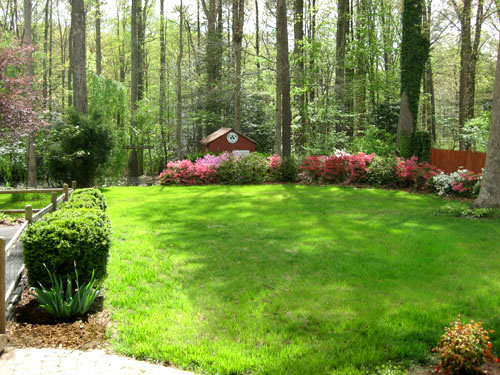
So although we’re hardly pro house-hunters (we’ve only done it two times), I think we’ve learned that the sweet spot for us is to completely ignore things we know we can change. If the walls are a color we don’t like, we don’t even pay attention since we know it can easily and affordably be updated. Same for the color of cabinets that we can potentially paint, or wallpaper that we can remove. Things that we can’t change as easily are what we pay the most attention to (ex: the floor plan of a house, the location of the kitchen and all the windows, the size of the bedrooms) – you know, things that would be a lot of money, and trouble, to alter.
For those who have a harder time seeing past the bad cosmetic things (like dated curtains and crusty old wallpaper) it probably helps to look at inspiration images in magazines, online, etc and save things that you love (in a binder, on Pinterest, etc). Then stare at them to see if any of those rooms could inspire something. For example, if you see a room that looks totally different than a potential home’s living room but look closer and realize it’s the same size and shape, you could totally repaint and hang curtains and otherwise decorate it to get that look in your space. Know what I mean?
Update: Oh and as for avoiding a money pit with structural issues or other expensive upgrades you didn’t see coming, we definitely value getting a thorough inspection! Of course they can’t always catch everything, but we’d never buy a house without one and you definitely have much higher odds of finding potential issues (and then being able to opt out of the purchase) than if you skipped the inspection. We hire someone super thorough who is highly recommended and in each case he spent a minimum of 3+ hours crawling under the house, on the roof, looking into vents, etc – our guy got verrry friendly with each house. It can definitely keep you from ending up with a lemon! At least for our two house purchases it has worked out well.
So what about you guys. What do you look for or look past when it comes to house hunting? Do you make must-have lists and must-not-have lists along with nice-to-have lists? It’s definitely smart because that way you won’t let something on the nice-to-have list creep into your brain and convince you buy a house that’s missing a few of the must-haves.